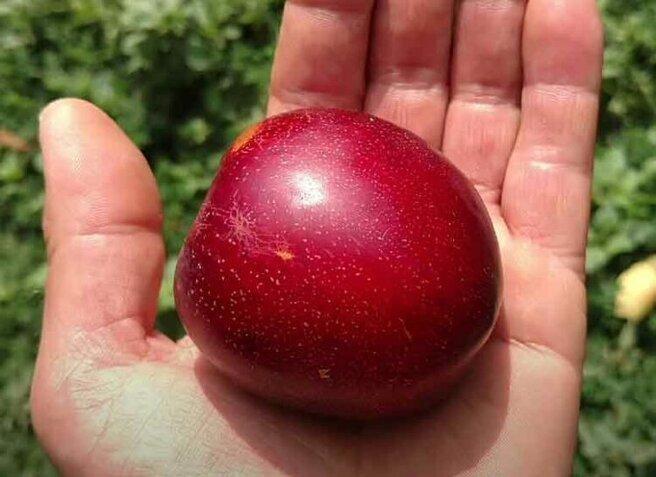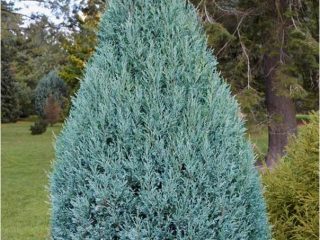Content
Thanks to the painstaking work of breeders, many new interesting crops have appeared, for example, Sharafuga Velvet Sunrise. Judging by the reviews of gardeners, it is distinguished by the excellent taste of the fruit, frost resistance and strong immunity. When growing a plant, it is important to become familiar with the general rules of agricultural technology.
Description of sharafuga variety Velvet Sunrise
A hybrid that combines the characteristics of plum, apricot and peach is called sharafuga Velvet Sunrise. It is suitable for amateur cultivation and deserves special attention due to its larger and sweeter fruits.

The sharafuga owes its appearance to the American biologist Floyd Zeiger
Description of sharafuga variety Velvet Sunrise:
- The height of the fruit tree is 3.5-4 m.
- The crown is semi-oval, dense, not very spreading.
- The skeletal branches and trunk are covered with smooth reddish bark.
- Shoots with thorns. The annual growth is 50-70 cm.
- The leaves are medium-sized, lanceolate, dark green in color.Their edges are curved like a peach.
Taste qualities
The fruits of the Velvet Cyraz sharafuga are purple in color. They are attached to a short stalk. They grow large, weighing up to 150 g and 8 cm in diameter. The shape of the fruits resembles apricots, and the structure of plums. The pulp is dense, pink-red in color with pronounced yellow veins. The taste is sweet and sour, with a peach aftertaste and a subtle apricot aroma.

Elastic skin reliably protects fruits from cracking
Productivity
The crop yield is high. Gardeners get up to 25 kg of fruit from one tree. The tree reaches its highest yield by the age of 10 and begins to yield up to 40 kg per season.

Sharafuga variety Velvet Sunrise is a fast-bearing tree that produces a harvest in the third year after planting
Flowering and ripening
When sharafuga blooms, the orchard is transformed. Large snow-white Velvet Sunrise flowers densely cover the skeletal branches of the tree. In the middle zone, the flowering period begins in May, and in the south of the country - in mid-April.
Frost resistance of sharafuga Velvet Sunrise
The sharafugi variety Velvet Sunrise is noted for its high frost resistance. It tolerates winters well in the middle region and can withstand temperatures as low as -26 °C. In addition, the plant painlessly survives short-term frosts down to -30 °C and spring temperature fluctuations down to -3 °C.
Keeping quality
The variety is lightweight and transportable. Fruits do not crack, do not fall off and can last for 12-15 days without loss of taste and marketability. During the harvesting process, you should try to preserve the waxy coating on them, since it contributes to better keeping quality.

Harvesting should be done in dry and clear weather.
Resistance to diseases and pests
Sharafuga is rarely damaged by pests and diseases. Compliance with the schedule of preventive treatments helps maintain Velvet Sunrise’s immunity at a high level.
Advantages and disadvantages
Sharafuga variety Velvet Sunrise overwinters safely in regions with moderately cold winters. The culture is unpretentious, but is demanding in terms of watering and soil composition.

The taste of this variety is impressive with a combination of apricot and plum notes, while many gardeners detect ripe banana in it
Pros:
- life expectancy;
- excellent taste of fruit;
- high shelf life and transportability;
- excellent yield;
- decorative type of tree;
- frost resistance;
- precociousness;
- reluctance to shedding;
- resistance to diseases.
Minuses:
- demanding conditions for growing;
- compliance with agricultural technology;
- tree formation.
Features of cultivation
Despite the fact that sharafuga grows well in the middle climate zone, it is a fairly heat-loving crop. Therefore, choose a bright place for planting, protected from gusts of wind.
Sharafuga loves watering. The fruits grow large, and their pulp is filled with sweet juice. An adult tree is watered abundantly as the top layer of soil dries. Up to 30 liters of settled water is added to the root.
During the dry season, the soil is moistened more often than during the rainy season. In the intervals between waterings, irrigation is carried out.After water procedures, the soil is loosened to saturate it with oxygen, and then mulched with mowed grass to retain moisture.
Sharafuga begins to be fed in the second year of life. By this time, Velvet Sunrise usually completely uses up all the fertilizers that were added during the planting process.
Diseases and pests
The sawfly, aphids, plum moth, and fruit moth are the most dangerous pests for sharafuga. Their largest accumulations are observed on the leaves, shoots, stalks and fruits of the tree. To kill insects, bio-insecticidal preparations are used, for example, Entobacterin, Lepidocide.

Pests are especially active in attacking young shoots of sharafuga, preventing the formation of fruits
All stone fruit plants are susceptible to gray rot. The disease appears when the orchard is in a neglected state. For preventive purposes, it is recommended to regularly remove fallen leaves and fruits, and to combat the disease, use fungicides Topaz, Fundazol or Fitosporin-M.
Peach curl is another disease that affects sharafuga. It manifests itself as swelling, yellowing or reddening of leaves, curvature of shoots, dying and falling of flowers. To treat Velvet Sunrise for curliness, use Abiga-Pik, Skor or a solution of Bordeaux mixture.

To prevent diseases, it is necessary to treat the tree with a 0.5-1% solution of copper sulfate
Conclusion
More and more often in Russian gardens you can find a fruit tree under the interesting name sharafuga Velvet Sunrise.The hybrid has good frost resistance, which is why it develops successfully even in the not too hot climate of central Russia. However, young trees need to be insulated for the winter, which will ensure their survival.
Reviews from gardeners about sharafuga Velvet Sunrise








